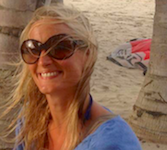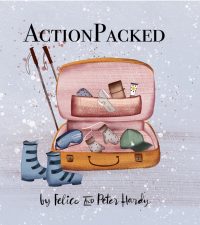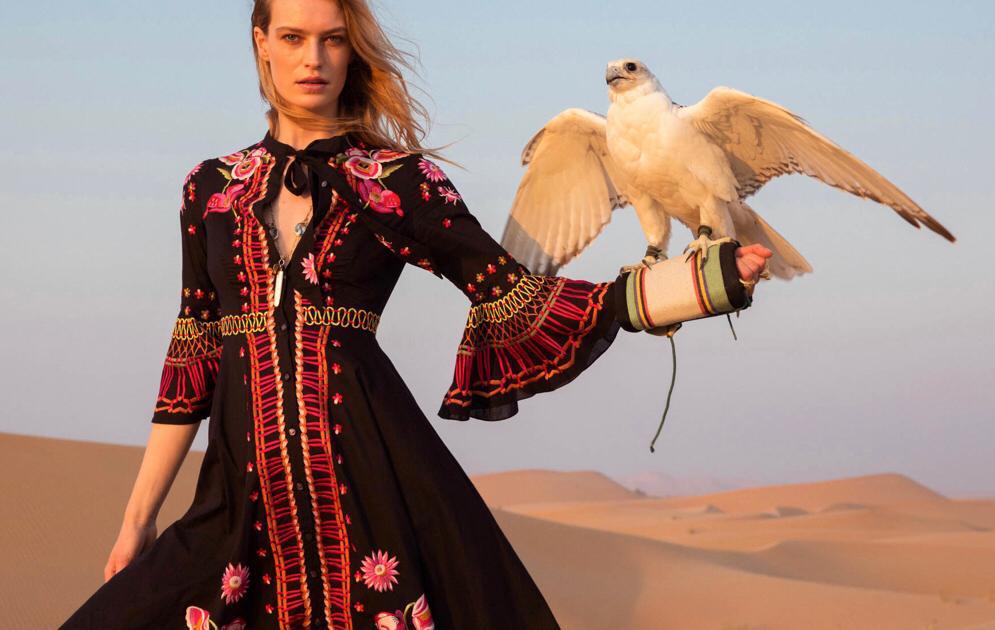
Peter Welcome to our travel podcast. We’re specialist travel writers and we’ve spent half a lifetime exploring every corner of the world.
Felice We want to share with you some of our extraordinary experiences and the amazing people we’ve met along the way.
Peter This week, we’re down on a cider farm in rural Somerset, in the southwest of England. It’s the home of top fashion photographer and worldwide adventurer, Matilda Temperley. Tilly started out as a scientist in Africa before switching careers. Action Packed Travel’s Louise Hall began by asking her how she became a photographer.
Matilda I didn’t go a normal route into photography. I used to work in disease control and I was working on the Ugandan-Sudanese border. And I’d got to a stage where I thought it wasn’t for me. I didn’t want to do this for life, and I was wondering what it really was that I did want to do. And I was racking my brains and I was thinking, ‘What have I enjoyed in life? OK, this is not going to be my life, so what is it that I can do?’ And I couldn’t really remember what my ambitions were when I was young.
When I was really young, I wanted to be a photographer and a trapeze artist, and so it was a time when I was realising the power of photography to tell stories. So I moved back to London not long after and called myself a photographer. I knew nothing and started learning the trapeze.
It was a roundabout route and everybody I was working with at the time was completely and utterly horrified. I learnt the trapeze and I loved it. I’ve got a trapeze here in my kitchen. I did my second performance. I was too old when I started, really. But I still love hanging on it, stretching. It’s like a meditation. But in my second performance in front of 450 people, I had tonsillitis and my boyfriend at the time who I’d persuaded to become a trapeze artist too, dropped me and I managed to break quite a few ribs in my back and that was the end of that. But one of my absolute best friends in the world is a trapeze artist; she’s called Katherine Arnold and all her hashtags are just Katherine Arnold. And so I live vicariously through her now.
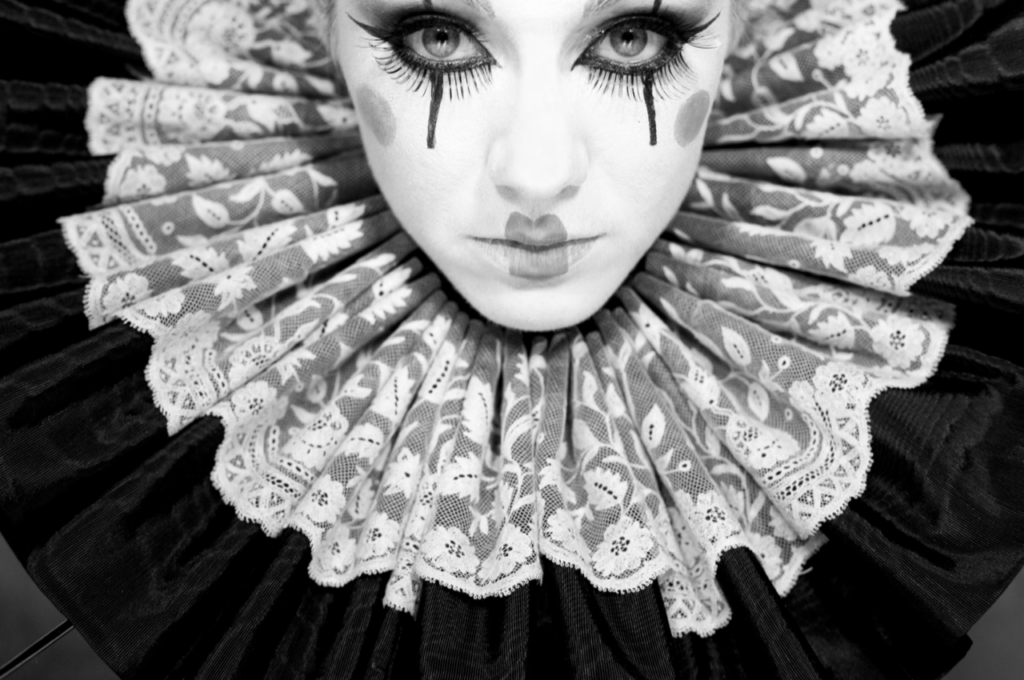
Katherine Arnold
Louise What was your first commission?
Matilda My first commission was a really amazingly lucky commission, actually, and it was combining photography and the circus, two great passions of mine. I think everyone always thinks they want to run away with the circus. And that feeling never has quite left me until this very day, in fact. And I was talking to someone about a project I was doing in Uganda at the time. And in a roundabout way, they offered me an exhibition on contemporary British circus for the Roundhouse in London, which is a big arts venue. And so I got this grant to travel all around the UK looking at contemporary British circus. And actually, really, it was the most incredible commission. And it’s what helped me to teach myself to be a photographer.
Louise Then there’s your Dancer series.

Performance
Matilda Right at the beginning when I was starting out as a photographer. Every time I had a shoot I’d invite people into the studio, people from all walks of life – Sumo wrestlers and all sorts of very intriguing circus artists. Dancers was part of that and having dancers in the studio I think has been the biggest privilege of my career as a photographer. You have these most wonderful performers come and do their performance just for you and we did have one day when I had some dancers, they were dancing in the Opera House and were all naked, painted as zebras and all the fire alarms went as so then you had all of these girls out on the street in London on a really rough place, completely naked, dressed as zebras with little towels around themselves. That was a memorable day. Dancing is a real joy to photograph.
Louise Haven’t you photographed a lion tamer?
Matilda Thomas Chipperfield, eighth generation lion tamer. The last of his kind in the UK, now lions in the circus are outlawed in the UK he’s been fighting to carry on with his lions. I first photographed him for my first commission and then I went back and photographed him about seven years later. I phoned him up and I said ‘Hey Thomas, where are you and can I come and photograph you?’ It was New Year’s Day and he said: ‘I’m in Aberdeenshire and it’s snowing.’ That was a 14-hour drive away. So I said, ‘I’ll be there tomorrow.’
I jumped in my car and I went up and it was bleak and his lions were in the snow and I took, I think, some of my favourite pictures ever of Thomas and his lions. They didn’t like me very much, if you ever turned your back on them they’d sort of leap from nowhere, and it was just a really interesting thing because it was such an interesting story being the last in the line. I followed his career avidly.
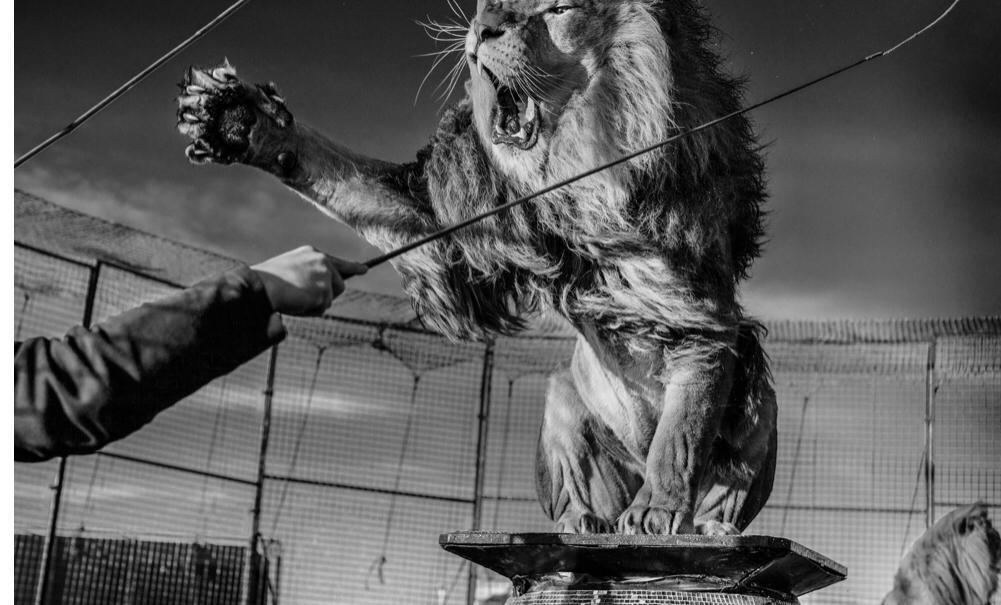
Britain’s last lion tamer, Thomas Chipperfield
Louise How many cameras do you own?
Matilda I don’t know. I think maybe seven or eight, but I could probably only find a couple in my house because I keep lending them to people and I’m not actually sure where most of them are. If it’s just personal work, I shoot quite a lot on a little Leica Q, which is just a fixed lens that can always be around your neck and I treat it really badly. Then if I was to do a studio job, I’d do it on a Canon.
Louise Who has most inspired you?
Matilda Now the most inspiration in photography world is an interesting one because when I started out as a photographer, I knew no one. I came to love all the greats, the really obvious ones like the Avadon and Sarah Moon and the Salgado. But what I realised was actually it was the subjects I was interested in. So I’ve always been inspired through the subjects. So photography, for me, has being a way to have adventures wherever you are, because it opens doors. It’s led to all my best adventures in life. People come and visit you and you delve into people’s life stories and I miss the early days where I was just so nosy about everything.
Louise What’s the maddest thing you’ve done for work?
Matilda The maddest thing? I think I had loads of mad adventures. I found myself in a documentary in Vegas completely randomly interviewing in bed an amazing – she was in her 80s at the time – burlesque artist called Tempest Storm, who was a one-time girlfriend of Elvis. So I was lying in her bed and she was telling me all about her love affair with Elvis. I used to get flown all over the place to photograph such amazing mad situations.
Louise Haven’t you been a stuntwoman yourself?
Matilda I have done some stunts myself. I actually did shoot a couple of years ago in Andalusia – it was amazing. It was with Legendary Motorbike Adventures, but we did it as a fashion shoot and no one could ride the motorbikes. I always used to ride motorbikes when I was young; they dressed me up and I’m really short – five foot four – and the model was six foot. I wasn’t the best stunt woman because I did drop the bike on one of the gritty roads. But yes, lots of bits and pieces like that.
Louise Your first book, Under the Surface, illustrates the devastating Somerset floods around your home in the winter of 2013/14. Surrounding 16th century houses, churches and farmland remain partially submerged for two months. The book, won the Royal Geographical Society‘s Environmental Photographer of the Year award, what was the story behind it?

Somerset floods
Matilda We live on what’s known as the Somerset Levels and there’s a flood plain but all the villages around here are built on the little islands and in the winter of 2013, I got a call from my mom and I was actually in a studio full of ladyboys in Thailand. She said, ‘You’ve got to come home and photograph these floods.’
I said, ‘But there are floods every year. Of course, I’m not coming home to photograph it.’ She said, ‘You really must. It’s something we’ve never seen before.’ And I dutifully came home and where I am now was completely underwater. My grandfather’s house, which is in the village, was completely underwater. He was evacuated at the age of 99 on New Year’s Day, and his house was under three feet of water for two months. And everybody in the village was horrified because actually, although there has been historical floods in the houses, there hadn’t been a proper flood since 1928.
At the time, there hadn’t been a huge rainfall. It was just a mismanagement of the rivers and it was a simple thing…all the data showed it. There was a big cover-up, and so the community were fighting and saying, ‘You know, this isn’t our lot. What you’ve done is you’ve blocked our river.’ There was lots of misinformation. So I started going around in my neoprene chest-waders, which I have a slight fetish about ever since, and finding everyone’s stories. There was such community spirit; it was like a Blitz spirit and it was really my Coming Back to Somerset Moment.
Louise What caused the rivers to flood?
Matilda We live on the river, the River Parrett. It’s been a manmade river system for almost two millennia. So the river’s always been dug and over the past 20 years, they’ve let it silt up, so there’s been no maintenance that’s been done and downstream it’s essentially become a plug. So when the river fills, it can’t empty like it has been designed to empty.

River Parrett
Louise You took some remarkable photographs but then you ran into an unexpected financial problem over the book when it was just about to come out?
Matilda I paid the printer; I had pre-sold lots of books, and I got a phone call from someone who said, ‘Have you seen the local news? The printer has gone into administration.’ They wouldn’t answer their phone. They wouldn’t answer the phone. They wouldn’t answer the phone. When I finally spoke to them, they said, ‘Tough luck. We’ve consulted our lawyers. You’re just a casualty of administration.’
I said, ‘Well, hold on a second, you’re personally liable.’ They said, ‘Tough luck.’ They bagged the money after they’d gone into administration. So I took some volunteers from my folks’ farm; we went and chained ourselves across the entrance. They were so embarrassed by it that I got my money back by the end of the day.
Louise That’s great. The book was printed?
Matilda It sold out. But even better was that it ended up getting printed in Italy because from the back of all of that press – there was obviously nothing else happening that day – loads of printers got in touch with me and people were really, really helpful. In the end, it was a much nicer story.

African boy
Louise You’ve spent many years photographing the semi-nomadic people in the Omo River region of southwest Ethiopia.
Matilda There’s a number of different ethnic groups down there, and it’s probably around half a million people are directly impacted by these sort of rapid changes down there. There’s lots of multifaceted changes. When I first started going there…it took me five days to get down there. Now you can drive, the roads all tarmac-ed, within a day or a day’s long drive. And so they’ve had huge problems. The national parks have been turned into multinational farms, the river flow has been stopped, there’s a huge influx of tourism, which is not very culturally-sensitive tourism. So you’ve got a huge range of peoples that are having their livelihoods forcibly removed from them. Their culture is being squashed and it’s been a miserable time for them. I was hoping that there would be some light at the end of the tunnel, but actually, it’s such an incredible place and it has been sort of decimated by this globalisation.
Louise How did you find travelling in Ethiopia?
Matilda Travelling in Ethiopia was brilliant and totally different at the very beginning when I first went down there. I have a great friend who’s from there. We would get the car stuck and we’d be digging in the mud for days and camping anywhere. We’d sometimes be turned away because it was too dangerous. I took my mum there a few times and once I couldn’t find her. She was being held down by five bare-breasted ladies who wouldn’t release her until I bought them a beer. There was lots and lots of adventures – we just wild camped and I loved it.
Louise Have you been frightened on location?
Matilda I’ve definitely been frightened loads of times. Camping is always a bit uncertain, and I had such naivety when I started out. Mostly the frightening things were actually just good stories at the end of it, many breakdowns in the Omo, there was always guns everywhere. I once turned up in a village and they said, ‘You’d better not stay here because we’re having a bit of a war with the neighbours and there were 15 people killed last night,’ just as it was getting to dusk. That was an uncomfortable evening.
The personal situation’s dangerous situations or perceived dangerous situations of which there were many. But maybe I’m a scaredy-cat. There was one particular day with a young model, it was her first ever shoot. We were just doing a test shoot to see if she was comfortable and we were in a field with a tame red deer and she was sitting there in a dress looking beautiful. This huge stag came up behind her and started pawing her and jumping on her chest. I’ve felt never, ever felt so utterly irresponsible. Actually, she was fine. It was quite a moment.
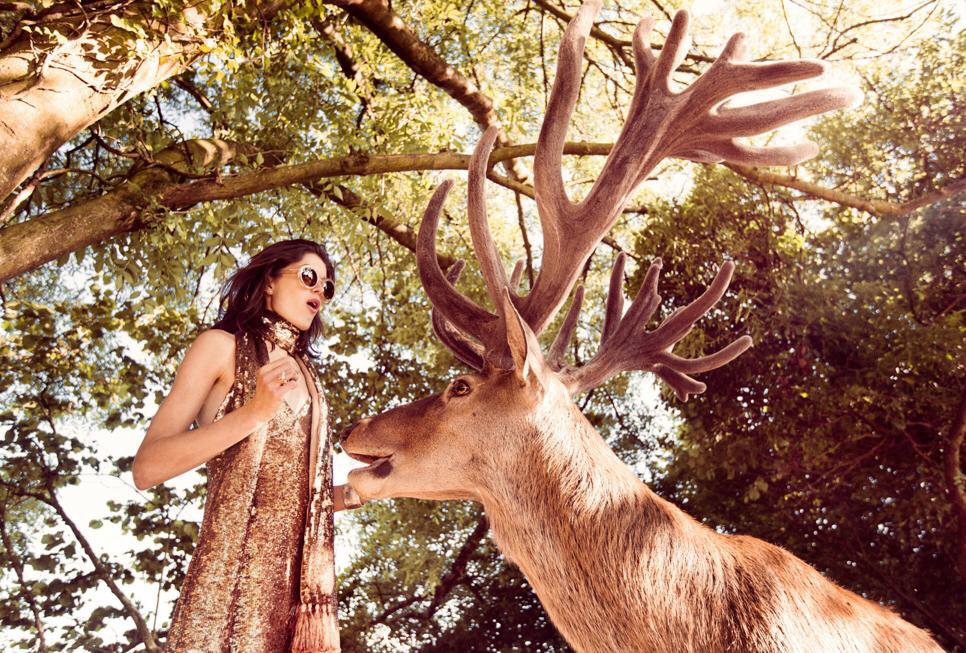
The girl and the deer
Louise Who’s your favourite travelling companion?
Matilda My favourite traveling companion ever is my mother, especially in Ethiopia, because, one, she’s obsessed by mud house – she builds them herself. And because it really changes their attitude when you’re with someone that’s older, she’s got really long grey hair down to her waist and people always want to touch her hair. She brings a very calm attitude to it.
Louise What’s been your physically most challenging commission?
Matilda My physically most challenging, I suppose I’ve got Crohn’s disease and my physically most challenging jobs have ironically just been in London in the studio when I’ve been ill and probably working too hard. There’s been some serious hot days in the desert. I did a 24-hour shoot in Vegas one day – that was a bit challenging. I did four shoots in one day from Zumanity, Le Cirque du Soleil to a desert shoot with an old burlesque dancer, to an overnight shoot in a porn shop…a fashion shoot in a porn shop. I remember feeling pretty broken at that moment.
Louise In complete contrast, your latest book is about American burlesque dancers.
Matilda This was a really funny book because this is an academic book by Oxford University Press, written by Kaitlyn Regehr who is an incredible academic and it is on Legends from American Burlesque. We were photographing all these elderly dancers who were getting on stage still in their Zimmer frames, stripping and wiggling their little tassels around. I just felt they were so incredibly inspiring. Then on the flipside of that, it was photographing this sort of neo-burlesque movement who hold these older ladies up as icons, but they are completely different from one another. Their inspirations, I suppose, and their political affiliations couldn’t be more different – this sort of liberal neo-burlesque movement to these quite elderly ladies who say things like: ‘They strip because they want to and we strip because we had to.’ So actually, the writing in the book is a really wonderful snapshot of a very unusual movement.
Louise Is that how you got into photographing the circus?
Miranda No, I was photographing the circus in Vegas…for some reason, a magazine company approached me once. I realised magazines in the UK don’t pay but in America they really do. They’d fly me over and I would photograph amazing things. I just so happened to meet a girl, Kaitlyn, who was writing her PhD thesis on this League of Exotic Dancers and Oxford University Press commissioned it, amazingly.
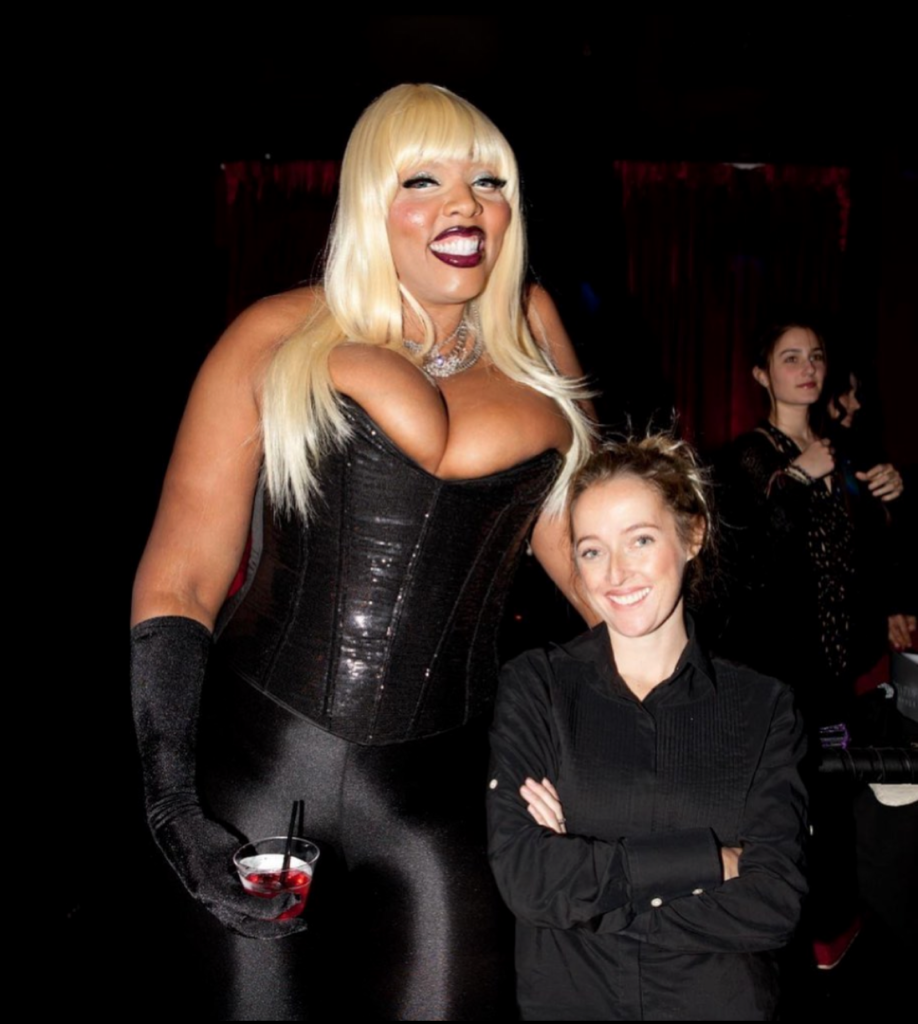
Matilda with Amazon Ashley
Louise There’s a crazy photo of you standing next to…is it a dancer towering over you?
Matilda I know what you mean. This was a really strange one. I’m not sure how to phrase it politically correctly these days, but there was a bar in Hollywood that I was flown to one day, and it was a bar where there was vertically-challenged people that if someone bought a bottle of vodka….they were dressed as oompa-loompas and they were hoisted onto the ceiling, tracked across the ceiling, then they would drop these bottles of vodka. Also there were vertically-challenged people, which I’m sure is not the P.C. way to say it, doing lots of tribute acts. The woman that you’re talking about in this picture with me, she was a hugely tall, amazingly massive woman called Amazon Ashley.
In that picture you’re talking about, I’m actually wearing high heels. Yes, it was the the strangest bar and I think it was a really popular Hollywood thing for a moment. Actually, the people on stage at that time and the people being tracked across the ceiling with Amazon Ashley, ended up on tour with Miley Cyrus. That was definitely one of the weirdest bars I have ever been to.
When I injured myself, I discovered a love for flying microlights. I think, like being on a trapeze, it’s like a meditation – there’s no room for error and you can’t think about anything else. So whatever happens at the end of it, you feel amazing. So always with fashion work, which can be, let’s face it, really boring to bring them into your life, to do things that are exciting for you is great. So why have a model in a studio when you could have her clambering around on a whole load of aeroplanes or go motorbiking in Andalusia or go riding in Oman or whatever it is. So any excuse to do exciting things.
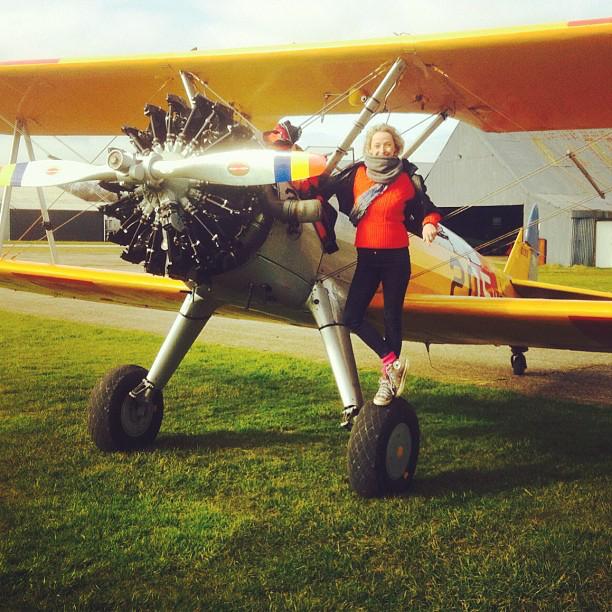
I was flying around in a microlight. Everyone else had helicopters during the Somerset floods…all the press. I was in this microlight dodging the rain and I loved it so much. I thought to myself, if I sell this particular picture, I will teach myself, I will pay to learn to fly. I sold the picture but I don’t think I ever got paid for it. I started to learn to fly, but I never quite finished my licence because I got distracted by paramotoring. Paramotoring is where you put a massive fan on your back, you have a soft wing that you run with, you run…and you run…and you run with your motor going, and get some lift to end up in the air. I got distracted by that for a while, but I will go back to microlighting at some point.
Louise How far and high have you flown?
Matilda Oh, not very high because it’s frightening. It’s like being a bird, it’s completely wonderful. I saw one fly over my house one day and I thought, ‘That’s for me, I’m doing that.’ I phoned up and booked myself on course the very next day. I had great plans. I thought, I’ll photograph loads from the sky, do loads of aerial photography and have complete freedom. I can fly to work. It didn’t quite work out like that. I did photograph a few things from the sky.

Louise What sports interest you these days?
Matilda What sports do I do? I do loads of walking these days. I like a little canoe. My little dog has just decided it’s quite happy on the front of the paddle board. Whatever sports come my way, I’ll give a go.
Louise What are you up to now? A peek at your Instagram shows you back at your farm tasting Somerset cider-brandy with AbFab British actress, Joanna Lumley.
Matilda Oh, she’s amazing. For this pandemic, I have taken over the running of my family business. I’ve always done bits on the side, so I’m a distiller as well. We make Cider and Brandy, and Joanna Lumley came to visit – everyone fell completely in love with her. A daily chore is tasting, these days.

Matilda on a shoot
Louise Usually you supply Britain’s most famous annual music festival, Glastonbury, sold from your bus. Is it happening this year?
Matilda There sadly is no Glastonbury Festival this year. So the cider bus will come out into the yard in the farm and we’ll bring a little festival feel to us every week.
Louise It looks like you’ve been out truffle hunting instead?
Matilda I did get truffle hunting. I have to say truffles…I love truffles, but English truffles are not quite the same as other truffles…let’s just leave it there.
Louise How is your lockdown?
Matilda Lockdown is interesting, challenging, like it was for everybody. But we’re lucky in so far as with farming apples and so work never stops on the farm. So actually, although we haven’t seen any anyone and desperately missed people and customers, it’s been nonstop.
Louise Can we come to visit your farm to taste your award-winning British cider? I’m after one of your crabapple cocktails.
Matilda You certainly can. At the end of April we will have the cider bus and I will be making cocktails all through the summer. We’ll have circus artists, we’ll have high-wire artists, we’ll have bands playing, we’ll have something different happening every week, whether it’s steam engines or whatever it is.
Louise Where can listeners go to find out more or to plan a trip to your farm to taste the fruits of your orchards?
Matilda If you go to SomersetCiderBrandy.com, you can read about the whole history and come to visit.
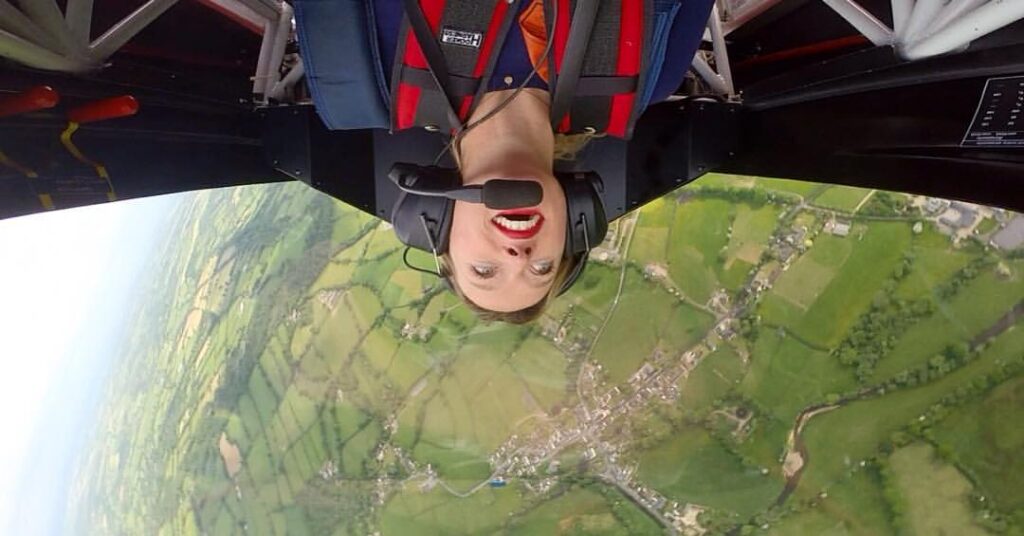
Matilda
Louise Finally, what’s your dream commission trip? What next? What would it be?
Matilda I think I’ve just had a dream commission, which is…you won’t find it on my website…but my dream commission was given to me by Somerset Museums a couple of years ago and they said, ‘Photograph Somerset, whatever you want to about Somerset.’ I’d just moved back and it just gave me an excuse to explore my local area. I actually came to realise that you can have such incredible adventures just by having the freedom to knock on your neighbour’s doors and find what’s happening around you. Without a camera, that’s really difficult. So, yes, we photographed Somerset and we ended up doing a small documentary that we’re still working on, which was Life in Somerset, which is carried on to find out what people are doing through the pandemic and how they’re coping with Brexit. So that’s bubbling away on the side.
Louise Thanks so much, Tilly, it’s been enlightening. When can we see and buy your work?
Matilda You can see my work on my website, which is MatildaTemperley.com, and you can buy prints from Lumitrix.com.
Louise We’ll put all the details on the show notes on the site. Matilda Temperley, thank you so much for coming on Action Packed Travel. We wish you the very best of luck in your fu career, be it as a fashion photographer, cider maker, distiller, pilot, trapeze artist and whatever else may take your fancy.
Felice That’s all for now. If you’ve enjoyed the show, please share this episode with at least one other person! Do also subscribe on Spotify, i-Tunes or any of the many podcast providers – where you can give us a rating. You can subscribe on Spotify, Apple Podcasts or any of the many podcast platforms. You can also find us on Twitter, Facebook and Instagram. We’d love you to sign up for our regular emails to [email protected].
© ActionPacked Travel
![]()
- Join over a hundred thousand podcasters already using Buzzsprout to get their message out to the world.
- Following the link lets Buzzsprout know we sent you, gets you a $20 Amazon gift card if you sign up for a paid plan, and helps support our show.
All photography by Matilda Temperley. To find out more about her work and to buy her books, visit www.MatildaTemperley.com
To buy prints of her works: www.Lumitrix.com
Matilda’s sell-out book, Under the Surface – Somerset Floods, won the Royal Photographic Society’s Vic Odden Award in 2015.
Her second book, Omo – Change in the Valley documents human rights abuses in Ethiopia.


